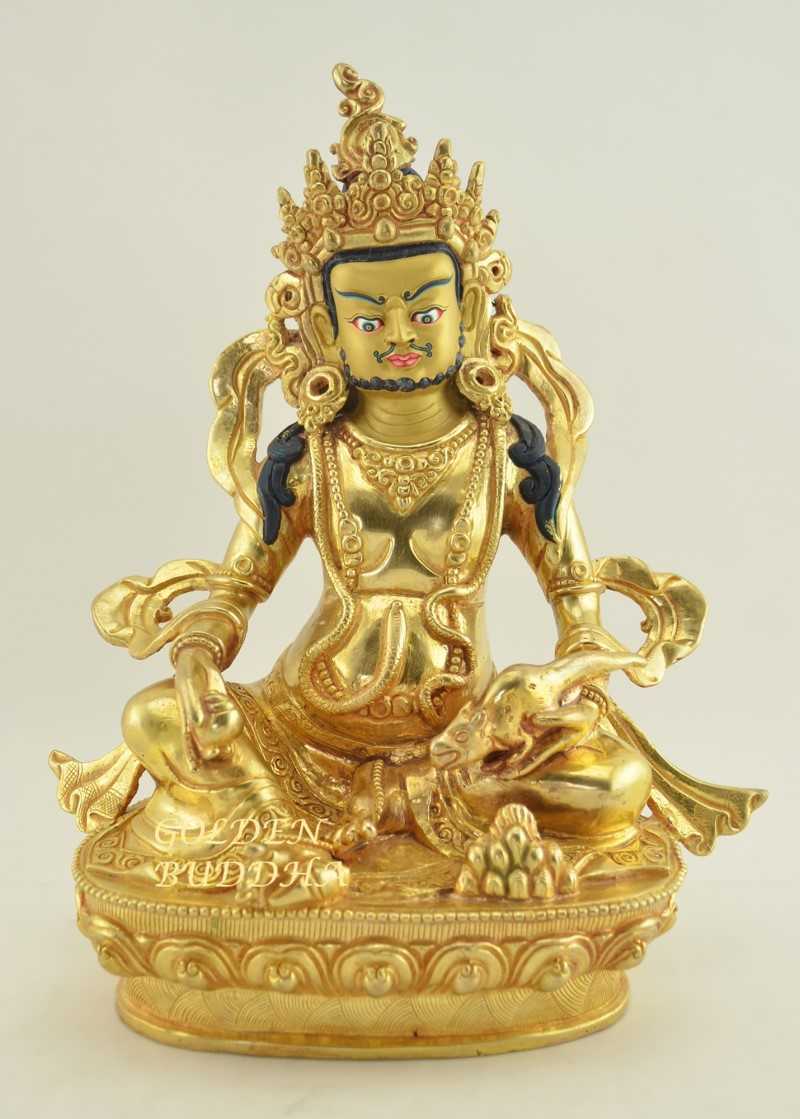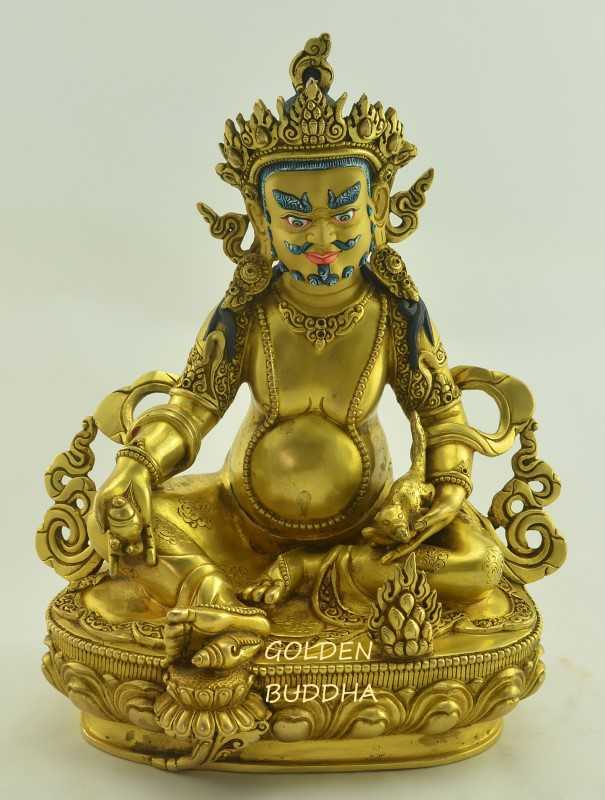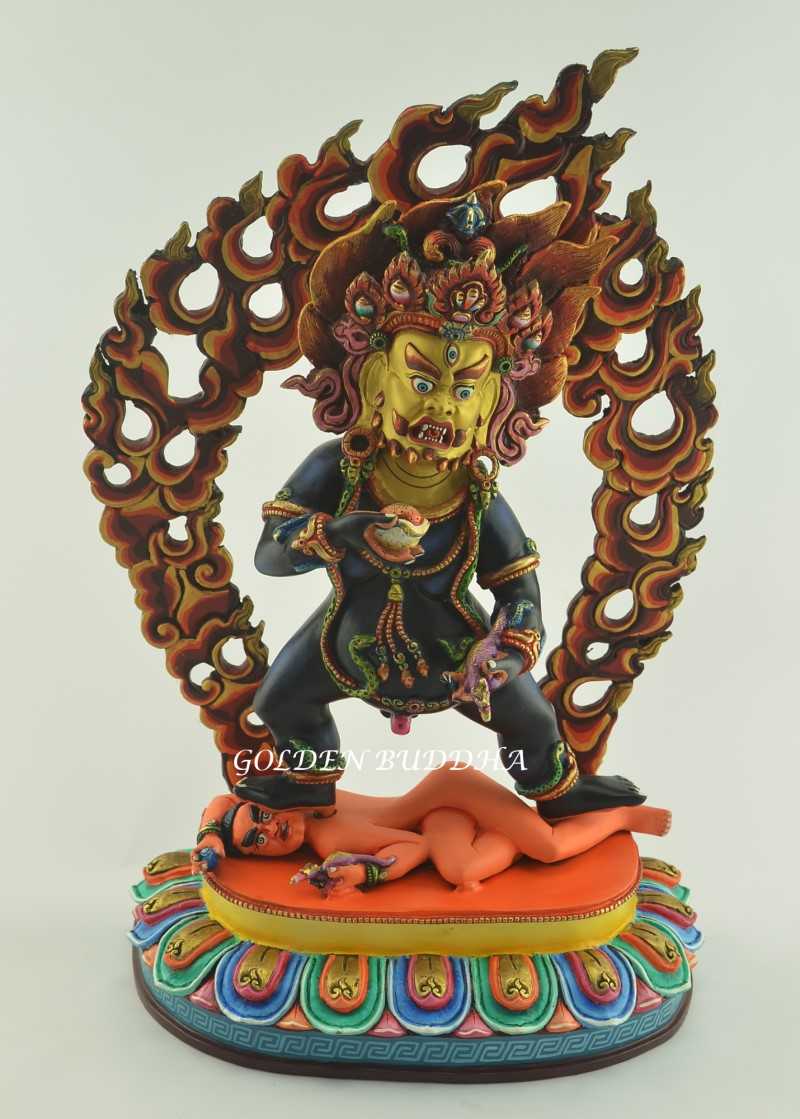Dzambhala statues originated from the Hindu god of wealth – “Kubera”. In Hinduism, Kubera’s mandate from the gods was to make devotees wealthy e.g. win the lottery. However, as Kubera was assimilated into Buddhism he took on the attributes of equanimity and compassion. As a result, he can still make devotees very rich but only if they combine their worldly desire with the virtue of generosity.
In Buddhism, Dzambhala’s purpose of wealth generation is to create opportunity for the impoverished. This is accomplished by relieving their burden of debts, bad luck and other extreme deficiencies. By creating basic opportunity, the impoverished can effectively practice the Dharma.
Five Types of Dzambhala Statues
Indeed, Dzambhala is defined as the “Precious Golden Deity” who brings the wealth of the Dharma and material security to our lives. As such, there are five types of Dzambhala statues and each is a member of the jewel family. There is a yellow, white, black, green and red Dzambhala. Additionally, each of them has the obligation to generate material and spiritual wealth for their devotees.
The five Dzambhalas each use different means to accomplish their goals. Nonetheless, it is also rather easy to find similarities between the five Dzambhalas. In this post I am going to analyze our Dzambhala statues for sale.
The Most Popular Yellow Dzambhala Statue
Yellow Dzambhala statues represent the most popular embodiment of Dzambhala. Yellow Dzambhala is typically seated with his right leg in panhandle and left leg pulled in. Additionally, he is adorned with the crown and jewels of a Bodhisattva and has a large protruding stomach.
However, his most unique feature is his mongoose Nehulay that is always seen perched in his left hand. Nehulay represents Dzambhala’s subjugation of the nagas (snakes) and he is always spewing forth precious jewels and treasures. Additionally, in his right hand and at the base of the statue are medicinal citron fruits that have healing properties such as relieving fever.
Yellow Dzambhala is an emanation of Ratnasambhava and he can eliminate poverty in the 6 realms of samsara. Additionally, he can generate virtue, wisdom and long life for devotees.
Yellow Dzambhala Mantra
Devotees are encouraged to recite his mantra, if so all of their material and spiritual needs will be met. The Yellow Dzambhala mantra is “Om Jambhala Jalendraye Svaha”.
Wrathful Nature of Black Dzambhala Statues
One of the most aggressive of the five Dzambhalas is Black Dzambhala. Similar to Yellow Dzambhala, Black Dzambhala statues are also depicted with the mongoose Nehulay. However, they are also very different in many ways.
First, Black Dzambhala is a wrathful emanation. As such, he is depicted with three glaring eyes and fangs. His mouth is scowling and has a ferocious look on his face. Additionally, he is holding a kapala skull cup in his right hand and he is stamping on a “yellow rich man”. Furthermore, Black Dzambhala is naked and sexually aroused. He wears snakes wrapped around his neck, ankles and wrists.
As with all wrathful deities in Tibetan Buddhism, their appearances belie the fact that their purpose is to defeat evil and greed. Unfortunately, sometimes it is necessary to fight “fire with fire” so to speak. As such, Black Dzambhala tries to relieve the urges which are created by extreme poverty.
For example, desperate needs sometimes result in desperate action such as theft, anger and violence. In order to preserve good karma and trample temptation, Black Dzambhala uses aggressive means.
Black Dzambhala Mantra
Devotees are encouraged to use the Black Dzambhala mantra “Om Indzali Mu Kam Dzamali Soha”.
Dzambhala Becomes A Protector of the Dharma (Dharmapala)
There is Buddhist legend that tells of how Dzambhala became a Dharmapala. However, there is more than one variation of the legend. Although they are quite similar, in one version the Buddha is attacked by demons and in another he is attacked with stones.
At one time, the Dzambhalas attended a sermon of the Buddha Shakyamuni. While the Buddha was giving the sermon a jealous dissident called Devadatta tried to attack the Buddha by throwing stones. However, the stones missed the Buddha and struck Yellow Dzambhala on the head and Black Dzambhala in the stomach.
When the Buddha saw this he came over to the Yellow Dzambhala and blessed the wound on his head with his hand. Additionally, there was a white clear fluid that came forth from his hand when he gave the blessing. After being touched by the Buddha’s hand and the white fluid, Dzambhala felt happy, calm and blissful. Also, his wounds were healed and they were cleared of all obscurations.
Dzambhala immediately bowed down and thanked the Buddha. After accepting their gratitude, the Buddha asked the Dzambhalas if they would become protectors of the Dharma and they readily agreed.
Pouring Water on Dzambhala Statues
As such the Buddha gave special instructions to the Dzambhalas to assist all devotees who invoke their powers by pouring water on their heads. If so invoked, they are to provide the devotee with material and spiritual wealth – especially spiritual wealth.
The Dzambhalas vowed to always do as the Buddha instructed. As a result, this has become the basis for followers of the Dzambhala Puja to pour water over the heads of their statues.




